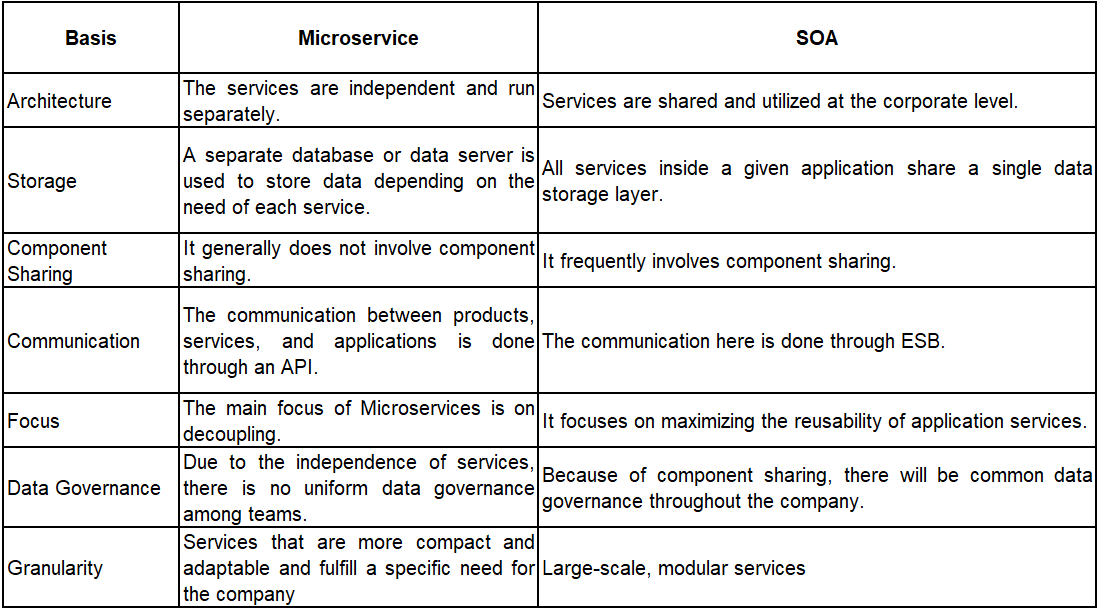Microservices Architecture and Service Oriented Architecture: Breaking Down Complex Applications
4 min read
03rd April, 2025
As the world is driving fast toward modern technology, the demand for modern models in enterprise software development and beyond is significantly increasing. The traditional software development models have become unusable or obsolete as the rise of modern software development models.
Two of the most prominent modern software development models include Microservices and Service-Oriented Architecture (SOA). There is very much similarity between the two, but they are actually not the same. They differ from each other in various aspects that we'll discuss in this blog.
Microservice: What is it?
Similar to SOA, microservice architectures are loosely coupled with specialized components that work independently of each other. These objects have a high degree of connectivity, called bounded context, meaning that they are independent groups with limited dependencies.
Microservices are cloud-native and run in containers, making them scalable and portable. They enable teams to quickly create new code, use different stacks for different features, and scale features automatically, reducing waste and cost.
The independence of microservices also makes them more fault-tolerant than other methods. The microservices approach uses APIs for communication between services, products, and applications. This allows independent services to be integrated into more complex applications.
What Are The Benefits Of Microservice Architecture In Custom Software Deployment Strategy?
Microservices architecture is a development approach that involves breaking complex applications into several smaller, independent services. Recently, microservices have gained significant prominence among developers as an architectural option worth exploring for custom software deployment.
Better Collaboration
Microservices enable better collaboration between development teams. The smaller size of each service translates into more manageable codebases.
Understanding and modifying each other's services becomes more straightforward for developers with this. Developer teams also find it easier to work on their services without risking the integrity of the more extensive application.
High Scalability
Scalability is critical to software deployment, mainly when dealing with large-scale applications. A microservices architecture allows developers to scale their applications effectively.
Developers can scale individual services experiencing high traffic volume rather than unnecessarily scaling the entire application. Additionally, microservices allow for elasticity, which means the ability to adapt to changes in traffic patterns in real time. This facilitates resource optimization and cost savings.
Improved Service Availability and Fault Tolerance
Microservices architecture enhances the availability of services by enabling services to be developed and deployed independently.
If a fault arises in one service at custom software development, it does not result in downtime in the entire system; this means that other services can continue with their operation without interruption. Moreover, microservices enable developers to design highly-available system architectures with proper failover mechanisms.
Best Development And Deployment Strategies
Microservices architecture enables faster development and deployment of custom software. Rather than developing and testing an extensive, complex application, developers can focus on developing and testing individual microservices.
This allows for quicker feedback on the quality and functionality of each service, reduces the chances of breaking the entire application when making changes, and simplifies the development process.
Deploying microservices is also more accessible, as each service is deployed independently. It reduces the impact of changes or updates and minimizes downtime.
Greater Flexibility In Custom Software Development
The ability for developers to use various technology stacks provided by microservices architecture increases flexibility. Depending on the particular needs of each service, a variety of programming languages, databases, and servers may be used to create it.
Developers can create and roll out services more quickly with access to various technologies.
Improved Resilience
Microservices enhance resilience by allowing developers to focus on building smaller, more robust components. This means that if a particular service experiences a fault, it does not affect the operation of other benefits.
Custom software development companies can build redundancy into each service, ensuring that failovers or fallbacks are available when needed. Additionally, since each service is developed individually, developers can efficiently perform fault tracing to identify and fix issues when they arise.
Better User Experience
Microservices contribute to a better user experience by enhancing the overall performance and speed of the application. Since each service operates independently, developers can optimize each service for implementation and ensure that data retrieval and processing is done efficiently.
This translates to a smoother, more responsive application that meets users' needs effectively.
Easier Testing
Testing an entire monolithic application is challenging and time-consuming. You can test each service independently, making diagnosing and fixing issues easier.
This software deployment strategy saves development time and greatly enhances the application's quality, ensuring that each microservice meets its specified requirements.
Moreover, since each microservice is independent, it is easier to simulate various conditions and test different scenarios, reducing the time and cost of testing.
Service-Oriented Architecture: What is it?
SOA is an approach to software development that deals with reusable software components or services that perform specific business functions. These functions are a combination of code and data; their interfaces provide loose coupling so that they can be called without knowledge of the underlying functions.
This loose coupling enables development teams to save time by reusing components in applications in other areas throughout the enterprise.
However, there are some risks associated with this approach, as issues related to one application may affect other interconnected applications due to shared access in the enterprise service bus (ESB).
SOA Provides Four Different Types Of Services
1. Functional services
2. Infrastructure services
3. Enterprise services
4. Application services
Each of the four service oriented architectures consists of three components that are: interface, contract, and implementation.
Advantages of Service-Oriented Architecture (SOA)
1. Services are designed to be reused across multiple applications, promoting consistency and efficiency.
2. Services can communicate to different platforms, languages, and technologies.
3. Teams can add, modify, or replace without affecting the entire system, increasing agility.
4. Scalable components can be reused across various applications.
5. Services are independent, reducing dependencies and promoting better module isolation.
6. Reusable services lead to faster development, as developers can leverage existing components.
SOA vs Microservices- Similarities
Before moving on to the differences between SOA and Microservices, let's first discuss their similarities.
- Both Microservices and SOA are known for breaking down complex applications into flexible components.
- Both offer improved scalability and customizable options to aid the organizations in developing and deploying apps more faster.
- The two development models prioritize agility based on cloud or hybrid cloud status.
So, these were the common similarities between the two development softwares but what makes them differ from each other? Continue reading to know that.
SOA vs Microservices- Differences

Which One Is Better For Your Business, SOA Or Microservices?
If you are here, then it means you must have read about the key differences between the two models that are described above. So now that you know what differs between the two models, one question will surely arise in your mind: which of them is a better option?
Both models have their own advantages and disadvantages in enterprise software development. SOA is beneficial for large and diverse application environments as it facilitates tight integration through ESB, enabling developers to connect different applications and messaging protocols.
However, SOA deployment is often more time-consuming than microservices. And it happens because the number of projects is interconnected and requires the whole application to be re-implemented when you add a new product or service.
In comparison to SOA, Microservice Architecture is simpler and quicker. It is so because it comprises smaller tasks that can be deployed faster and easier. Microservices are best for organizations that operate on a small scale and do not require a complex communication platform. It offers brilliant speed, scalability, and flexibility and also entails fewer costs and complexity.
Microservices architecture offers numerous benefits in custom software deployment. The advantages of microservices are apparent, from flexible scaling to improved service availability and fault tolerance and greater collaboration between development teams to reduce deployment time and enhance resilience.
This is why custom software development companies embrace microservices and leverage them in their software design and deployment endeavors.





















